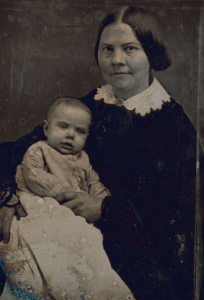This is a guest blog by Elizabeth A. Novara, a historian in the Library’s Manuscript Division. The wedding described here can be found in the Blackwell Family Papers.
On May 1, 1855, Lucy Stone and Henry Browne Blackwell were joined together in marriage. The well-publicized wedding ceremony, 165 years ago this month, was unusual for the time.
For one, Stone insisted on retaining her birth name, a decision that was shocking in a period where women’s legal identities were subsumed under those of their husbands. Two, the couple protested married women’s subordinate status in society by removing the word “obey” from their marriage vows. They also published a formal protest pamphlet arguing for equality in marriage.
The original pamphlet is featured in the Library’s “Shall Not Be Denied: Women Fight for the Vote” exhibition in the section “Love and Protest in a Suffrage Marriage.” Also included in the exhibition is one of the letters that Blackwell and Stone exchanged as they planned their vows.
Lucy Stone with daughter Alice Stone Blackwell, ca 1857. Prints and Photographs Division.
Stone had originally decided never to marry, as she did not want to submit to a husband’s demands and legal rights. But Blackwell’s persistence and his dedication to equal rights principles changed her mind. Their protest pamphlet underscored the legal restrictions married women endured at the time: A wife was not entitled to her own person, guardianship of children, ownership of real estate or her own wages, nor could she inherit property in most circumstances. The beginning of the protest illustrates how strongly they felt about these injustices:
“While acknowledging our mutual affection by publicly assuming the relationship of husband and wife, yet in justice to ourselves and a great principle, we deem it our duty to declare that this act on our part implies no sanction of, nor promise of voluntary obedience to such of the present laws of marriage as refuse to recognize the wife as an independent rational being, while they confer upon the husband an injurious and unnatural superiority, investing him with legal powers which no honorable man would exercise, and which no man should possess.”

Henry Browne Blackwell, ca 1850s, Prints and Photographs Division.
Meanwhile, in the 1840s, Elizabeth Cady Stanton and other women’s rights supporters in various states had successfully fought for the passage of the Married Women’s Property Acts, which allowed wives to control their own property. Still, these acts did not completely rectify married women’s status in society. Nor did they go unchallenged.
Stanton, who had organized the first women’s rights convention in Seneca Falls, wrote to Stone upon hearing about her decision to retain her name. Stanton declared, “Nothing has been done in the Woman’s Rights movement for some time that so rejoiced my heart as the announcement by you of a woman’s right to her name. To take a name is one of the first steps in freedom, and one of the first demands in a republican government.”
Stone’s contributions to the suffrage movement are often overshadowed by figures such as Stanton and Susan B. Anthony, but Stone was just as important to the movement. Stone’s correspondence demonstrates her activism as well as her connections with anti-slavery activists and equal-rights advocates. As a student at Oberlin College in 1847, Stone already knew she would fight for abolition and women’s rights. In a handwritten copy of a letter to her mother, she wrote, “I expect to plead not for the slave only, but for suffering humanity everywhere. Especially do I mean to labor for the elevation of my sex.” She did. Stone became a famous orator, holding audiences spellbound with her anti-slavery and women’s rights speeches.
In 1869, when the suffrage movement split over supporting the 15th Amendment, which granted voting rights to African American men but not to women of any race, Stone and Blackwell agreed to place their wishes on hold. They hoped women’s suffrage would be granted soon after the 15th Amendment was passed. It wasn’t.
Still, Stone and her husband continued to support equal rights for women and founded the American Woman Suffrage Association (AWSA) in 1869. Stanton and Anthony formed a rival organization, the National Woman Suffrage Association (NWSA). To rally support for the cause of voting rights for women, Stone and Blackwell began publishing The Woman’s Journal in 1870. It would far outlast Anthony’s rival journal, The Revolution, which ceased publication in 1872.
When the women’s suffrage movement reconciled in the 1890s and formed the National American Woman’s Suffrage Association (NAWSA), Alice Stone Blackwell (Stone and Blackwell’s only daughter) played a significant role. She became the editor of The Woman’s Journal, which was the primary national journal for the suffrage movement until it ceased publication in 1931. She also published a biography of her mother in 1930.

The couple late in life, gathered for a family photo, ca 1880 to 1890. Back row, l-r: Dr. Emily Blackwell, Ainsworth Spofford, Alice Stone Blackwell, Lucy Stone; (front row, l-r): Henry Browne Blackwell, Florence Spofford, Sarah (Partridge) Spofford.
While Lucy Stone did not take the Blackwell name, she did become part of an extraordinary family, full of women and men interested in improving their world. You can discover more about them by transcribing some of their correspondence, diaries and other historical documents online. In addition to the newly released digital collections, both the Blackwell Family Papers and the NAWSA Records are available for crowdsourced transcription via the Library’s By the People project.
Subscribe to the blog— it’s free! — and the largest library in world history will send cool stories straight to your inbox.















